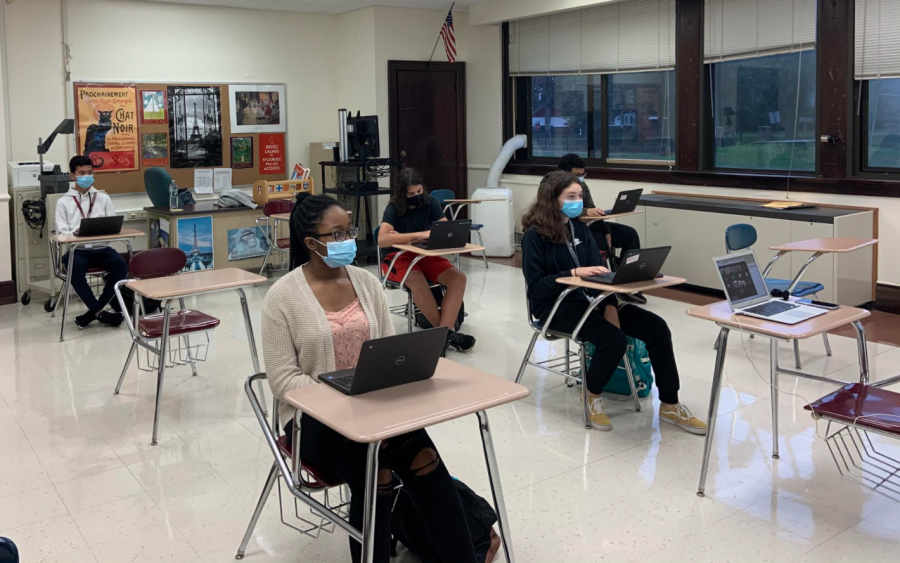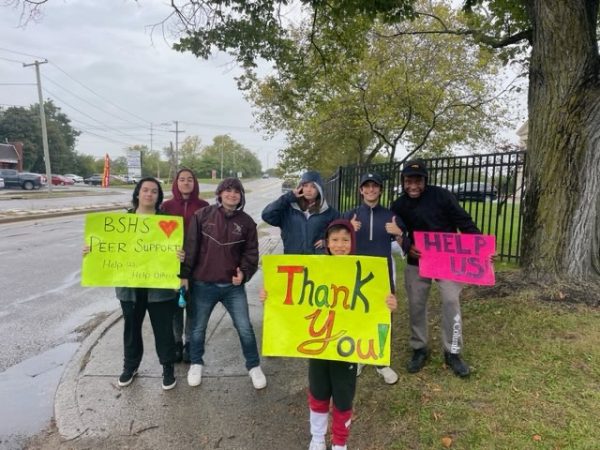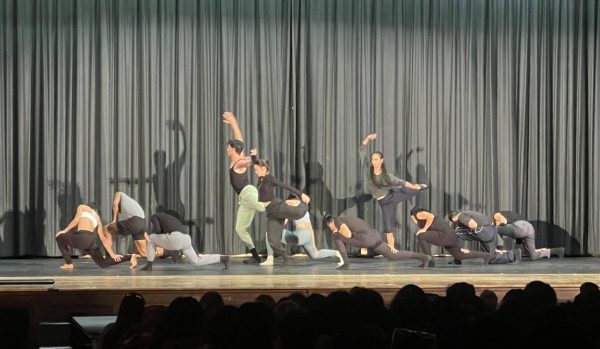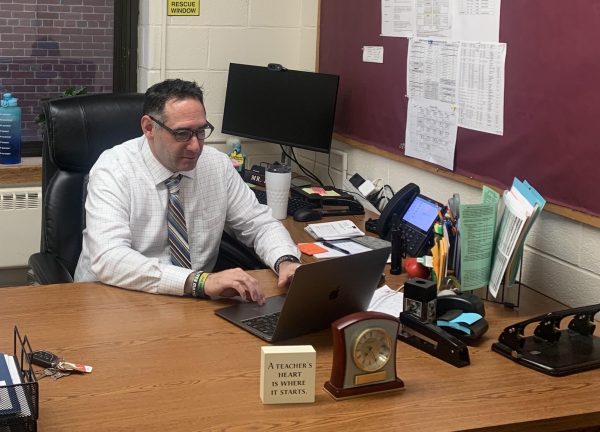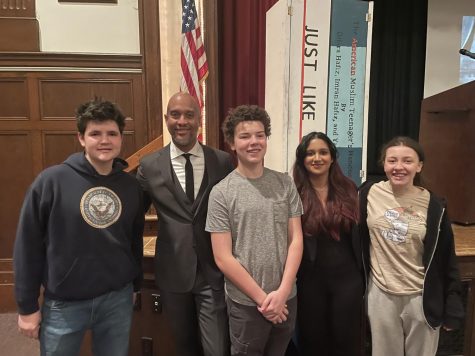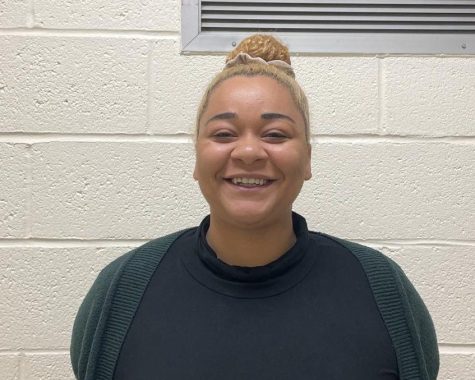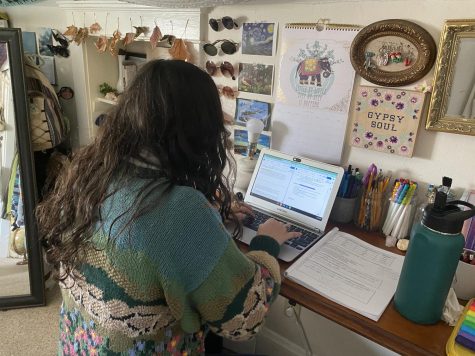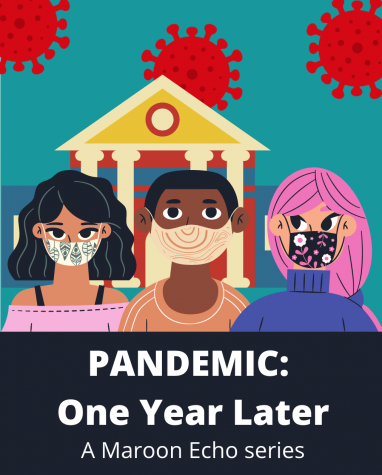Hybrid learning gives students a taste of in-school normalcy
Photo by Alyson Swenson Students sit at socially distanced desks on the day they are scheduled for in-school attendance. The district instituted a hybrid schedule that permits only half the class to attend on alternate days to allow for spacing between pupils. Students utilize Chromebooks to minimize papers exchanging hands; they also use the laptops on days they are at home.
March 12, 2021
Prior to the 2020-2021 school year, the community was introduced to hybrid learning – a blend of in-person and online education. Families were given the option for their child to attend school every other day with half the hybrid students or to stay home and learn virtually (to read more about virtual learning, click here). About 70 percent of the student body attends school in the hybrid scenario, according to guidance figures.
“I chose hybrid learning instead of fully virtual because when quarantine hit [in March 2020] and we were given assignments I couldn’t concentrate,” said Elizabeth Leon Sarmiento, freshman. “I would always find something to distract myself. Although home is nice, it’s not the learning environment for me.”
When the COVID-19 reached New York in early March 2020, the state closed all schools for a few weeks to flatten the curve, necessitating fully virtual learning; it then shuttered buildings until the end of the school year in June. After three months of students not being in a classroom setting, the district felt it was important to return to some form of in-school learning, according to a statement released by Joseph Bond, superintendent, prior to the 2020-2021 school year.
“I feel like nothing can compare to actually going to school for seven hours and leaving the school confidently knowing I learned something new,” said Jayde Nieslen, junior. “When I’m in school, I learn way better than being at home and accidentally losing my focus doing things like going on my phone and scrolling through Instagram.
A study published in the Journal of Instructional Research compared two hybrid classrooms that varied in the requirements of time spent online. The findings revealed the average increase in performance on three final assessments was 17 percent higher than students taking traditional classes, regardless of how much time the students were required to spend online.
“This type of learning has been beneficial because my teachers have really taken the time to teach much more in-depth now,” said Megan Leggio, sophomore. “We can grasp the topics thoroughly and we are prepared for other topics that we move onto next.”
A hybrid schedule reduces the number of students in each classroom to better allow for social distancing, according to Vox. While it may reduce the number of people each student interacts with – since students often stay with the same smaller group – it doesn’t necessarily reduce the number of student contacts for teachers, since they teach the entire hybrid group.
“I don’t necessarily believe that there’s a safer way to do this as of right now,” said Ariana Stathopoulus, senior. “People are trying their hardest to stay healthy and schools are trying their hardest to keep us safe and to make sure we get the correct education that we deserve.”
Due to the pandemic, a majority of students report being stressed, anxious, financially challenged, and socially isolated, according to a study on education sponsored by Microsoft.
“Everyone in the class is always quiet,” said Leon Sarmiento. “It benefits me because in most of my classes from middle school, classmates would usually always talk and that required more focus for me, like in science.”
As of Election Day 2020, more than 26 percent of American students were attending school in a hybrid situation that included two or three in-person days per week, according to NPR.
“It took me a long time to get used to hybrid learning,” said Stathopoulus. “In the beginning, I thought I couldn’t do it, but as time went on I got used to it. On the days I’m remote, I wake up a lot later – I have an extra hour to sleep in. I found that when I am well-rested and sleep longer I focus better.”
Adolescents need 60 minutes a day of moderate to strenuous exercise a day, according to Dr. Valerie Scott from Roper St. Francis Hospital in South Carolina, which may be difficult to achieve as pandemic learning necessitates sitting in front of a computer for class.
“I wanted to get some sort of normality in my life again, to have a chance to socialize with other people and feel physically active just by walking from class to class.,” said Nieslen. “Being cooped up inside for 3-4 months straight and just laying around wasn’t good for my mind and body”
Teachers are finding that in a pandemic classroom, it takes twice as long to conduct classroom discussions because, according to HutchPost, they have to specifically call on students.
“In-person is slightly better because the teachers are right in front of me, there are no technical problems,” said Leon Sarmiento. “An example would be when I was asked to read part of a story, [the teacher] called on me, but I didn’t answer right away because I had to yell at my sister to turn off the blender. I don’t have my own workspace; I sit at the dining table.”
Students and teachers alike are facing too many hardships, according to a 2020 EdWeek study, distracting from the main premise of the hybrid system, which is teaching/learning.
“ I love teaching and my job, but this has been beyond challenging,” said Alison Mauri, math teacher. “I hope it ends sometime soon.”

